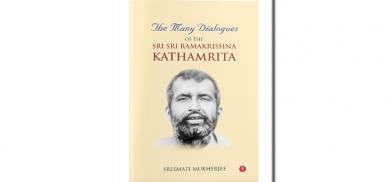Ramakrishna Paramhansa: A mystic, saint and philosopher despite being 'unlettered'
The Kathamrita records Ramakrishna as saying that no faith should be disrespected or denigrated; references to Christ and the Bible are part of its great fabric

Born in the 19th century when Bengal was undergoing major convulsions, Ramakrishna Paramhansa (original name Gadadhar Chhattopadhyaya) came to exercise one of the most profound influences on Bengali society. For someone who didn’t finish his school education and called himself unlettered, this was no ordinary achievement. With his extreme devotion to Goddess Kali, Ramakrishna became a mystic and guru (preceptor) to countless men and women, including one who later became famous as Swami Vivekananda.
One of his close disciples was Mahendranath Gupta (popularly known as M), who met Ramakrishna in 1882 and began keeping meticulous notes of the saint’s conversations and actions until the latter passed away. This led to a five-volume classic in Bengali titled Kathamrita, which has since come to be recognized as sacred scripture. Author and academic Sreemati Mukherjee - a Fulbright scholar who teaches at the Department of Performing Arts, Presidency University, Kolkata - delves into Kathamrita to uncover the many moments of the dialogic interface between song and philosophy, faith and empiricism, myth and scientific actuality, story-telling and historical documentation, bhava and reason. She achieves her goal beautifully.
In the process, Ramakrishna’s spiritual practices, his evocative teaching, his revolutionary pluralism, his splendid powers of narration, metaphor creation and usage, and his great ability to fuse song with philosophy provide a rainbow range of personality and one of the widest reaches of impact in terms of society, culture, religion and spirituality. As Mukherjee rightly says, this gave birth to the ‘era of Ramakrishna’. So much so that even the British, otherwise not open to Hindu society and rituals, came to regard Ramakrishna with a sense of respect.
The world of the Kathamrita spans the many images of Maya and Brahman, mythological birds, characters from the epics and Puranas, multiple forms of bhakti, birds that sit on a ship’s stern and become symbols of one-pointed concentration and much more. Ramakrishna’s ability to fuse and synthesize, recast and re-imagine images sanctified by tradition and bring them into dialogue with the colonial reality of 19th century Bengal allows the text to be both timeless and contemporary.
Bhakti or deep devotion is the clarion call of the entire Kathamrita. “Bhakti is everything,” Ramakrishna says. To everyone, the saint underlines that nothing can be achieved in life unless one surrenders to God. This is a recurring theme. “The person who remains devoted to the lotus feet of the Lord and still does his householder duties is a true hero.” Indeed, Ramakrishna gives primacy to Bhakti Yoga, saying true yearning, chanting and prayer will certainly lead to God. Bhakti is also “easy and good”.
Influencing people
In Kathamrita, the saint meets a sinner too; the author refers to the encounters between Ramakrishna and Girish Ghosh, an actor, a playwright and a director. The exchange between the two is one of the most charged and dramatic in the classic. At a time when not everyone was enamored of Girish Ghosh because of the involvement of women from disreputable families in theatre, Ramakrishna ended up positively influencing the man. So much so that Ramakrishna angered many devotees by visiting the theatre to see Ghosh’s Chaintanya Lila.
Dr. Mahendralal Sarkar, a homeopathic physician who treated Ramakrishna during illness, was not a believer to start with. But he soon began spending hours with the saint, giving his other patients a miss. The doctor was well-read. To him, Ramakrishna said: “A great deal of knowledge is ignorance… That God pervades the universe is true knowledge.” The greatest and most subtle questions about life and action are debated in Kathamrita.
The Kathamrita records Ramakrishna as saying that no faith should be disrespected or denigrated; references to Christ and the Bible are part of its great fabric. Ramakrishna tells M that as long as one has ‘shame’, ‘hatred’ and ‘fear’, one will never realize God.
The saint, Mukherjee says, pulled in music, poetry, story and analogy to give his teaching a rare poetic intensity, musicality and radiance. Through homely illustrations, Ramakrishna effortlessly illuminated areas of psychological, spiritual and everyday relevance that constantly intersect and inflect our lives. The logic of music and the logic of divine fervor overrode all other considerations for Ramakrishna.
“Perhaps no other religious text in the world is this polyphonic or multitudinous, with a melodic resonance that is almost unsurpassable,” says Mukherjee. The author aptly remarks: “Ramakrishna was not a formal philosopher or poet but he was all this and much more.”
Mukherjee’s book is the easy answer for those who cannot read Kathamrita in its original Bengali.
(The Many Dialogues of the Sri Sri Ramakrishna Kathamrita; Author Sreemati Mukherjee; Publishers Hawakal Publishers; Pages 259; Price Rs 650)
(The reviewer is a veteran journalist who writes on diplomacy and politics. He can be contacted at ranjini17@hotmail.com)










Post a Comment